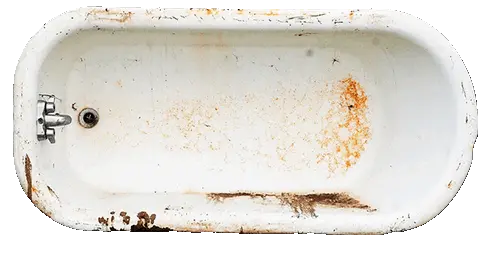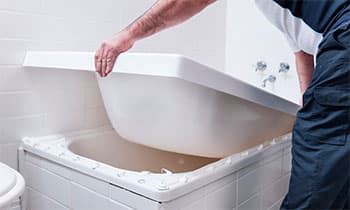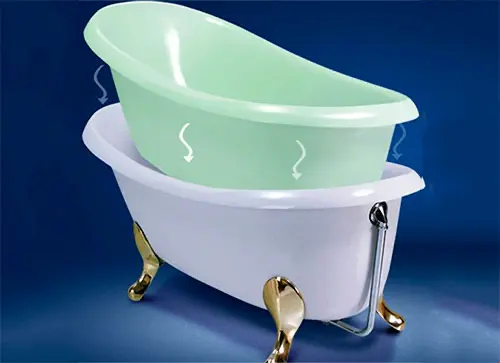Bathtub Liners
Is a bathtub liner the right option for renovating your tub? At first glance, it might appear to be a quick and easy fix. It doesn’t involve removing and replacing your whole tub, and it doesn’t require a lot of surface prep work. It would seem that you pretty much just drop the insert into place and you’re set. But in truth, placing a bathtub insert is actually quite an involved process that requires careful attention to detail. It may surprise you to find out how complex the procedure really is.
If you’re interested in sprucing up your bathroom, you don’t necessarily need a complete overhaul. Since your bathtub is the biggest fixture and captures the most attention, sometimes just restoring it is sufficient to brighten up the whole room.

If your tub is outdated, looks worn out, is damaged or has lost its luster, it drags down the appearance of the whole bathroom.
You may have considered removing your tub and installing a new one, but hesitated at the thought of the time and expense involved. Often, the walls and floor are damaged in the process, and that means an even more extensive project – and shelling out more time and money.
However, there are other alternatives that don’t involve replacing the tub. These options can save you time and money, as well as a lot of headaches. They don’t involve a major remodeling project, but they can revive your tub and improve the look of the entire room. Installing an plastic liner or bathtub insert is one of those methods.
Bathtub Liner vs. Pour-On Application: A Clear Comparison
Here’s a comparison of two alternatives that don’t involve replacing the tub – a bathtub liner and reglazing with liquid enamel:
| CRITERIA | Bathtub Liner | Pour-On Application (Our Method) |
| Durability & Issues | Up to 10 years. Prone to water-trapping & mold. | |
| Installation Process | 2-3 Day multi-step process | |
| Ready to Use | Immediately | |
| Impact on Tiles | High risk
| |
| Overall Value | High initial cost. Feels hollow & can crack. | Superior value. Solid, integrated finish. |

What is a tub liner?
A tub liner is a shell that’s placed inside your existing bathtub. It’s engineered to be the same size and shape as your tub, and it’s glued into place to completely cover the tub. It gives the tub a white, glossy appearance like that of a new acrylic tub. It offers advantages similar to those of an acrylic tub:
-
It has a clean, smooth finish, brightening up your bathroom and providing a pleasant bathing experience
-
The non-porous surface is easy to clean and maintain since it repels dirt
-
It resists microbes and fungus, so you don’t need harsh chemicals to disinfect it
-
Acrylic requires less energy to manufacture compared to other materials, resulting in a lower environmental impact
The durability of a bathtub liner depends to a large extent on the quality of the installation. If not properly installed, acrylic can be fragile and prone to cracks because of uneven pressure. The installation process involves several steps that must be followed closely to ensure a long-lasting outcome.
The Installation Process of Bathtub Liners
The existing bathtub does not need to be removed to install a liner. This is one of the main advantages, especially for cast iron tubs that are strong and heavy.
Before starting the installation process, the existing drain and fittings are removed. Then the first row of tiles is removed from the wall so they do not interfere with the installation of the liner. Once everything is ready, the tub is ready to be prepared for installing the liner:
-
The bathtub is washed and dried, making sure that no moisture remains. The drain opening and overflow are caulked with silicone to prevent moisture from seeping into the space between the tub and liner and growing mold.
-
The holes for the drain and overflow are marked on the liner and carefully drilled out. This requires a keen eye and precise attention to detail.
-
A special foam is applied to the surface of the tub in a criss-cross pattern to make certain that there are no gaps or excess sealant.
-
The liner is placed inside the tub, taking care not to disturb or scrape off the foam. The holes for the drain and overflow are matched up, and the sides are sealed around the perimeter.
-
Once the insert is adhered securely and any excess sealant is removed, the drain and overflow fittings are reattached.
-
The joints between the tub and wall are sealed to create a finished look and protect from water damage.

Now that the installation process is complete, the tub is filled as full as possible with water. This spreads the weight over the entire area of the tub and helps the liner adhere firmly to the tub.
Most professionals advise letting the tub dry for at least 12 hours or overnight. You’ll want to take care when using your tub during the first few days to be sure that the liner is well adhered so it won’t crack.
The service life of a well-installed tub liner can be 10-15 years. Besides installation, another important factor to consider is the quality of the tub liner itself. For maximum durability, the tub liner should be at least ½ inch thick.
Benefits of Bathtub Liners
-
Repairing a bathtub by installing a liner is much faster and easier than replacing it. Once the work is started, it can be completed in a few hours, and in most cases it’s ready to use the next day (although you need to be careful with it for a few days).
-
Bathtub liners are more affordable than tearing out and replacing your tub, and liners give a smooth, like-new finish.
-
The durability of bathtub liners makes it an attractive option for property owners looking for a cost-effective solution.
Drawbacks of Bathtub Liners
-
Bathtub liners usually come in standard sizes, which do not fit all shapes and sizes of tubs. If your bathtub has an unusual size or shape, acrylic liners are probably not a viable option for you.
-
Installation involves some renovation and repairs to the bathroom itself. The first row of tiles adjacent to the tub will need to be removed before installation and then replaced. This entails additional expense and inconvenience.
-
Installing a bathtub liner is not necessarily less expensive than replacing the tub. A high-quality liner can cost as much as a new tub, and the cost of installation and removal and repair of the tiles also adds to the expense.
-
Bathtub liners tend to be fragile. The impact from a heavy object being dropped can crack and ruin the liner, making it unusable. Also, many liners can support a maximum of 155 pounds, which limits the possibility for many families.
-
If the liner is poorly installed, moisture can seep into the space between the tub and liner, and mold and other microorganisms can start to grow. This can destroy the sealant between the liner and the tub, significantly reducing the durability of the liner.
-
The installation time takes at least a week from start to finish. The specialist must first come out and take measurements and order the tub liner. Once it has been received, the installation process can begin. The process itself takes a few hours, but it has to dry before using it, so it’s not immediately ready for use.
-
Errors in installation can reduce the durability of the liner. If it’s not perfectly aligned, it can crack, so it may last for only 1-2 years.
-
The liner is always smaller than the tub itself. If the tub is small to begin with, the liner will make the tub even smaller.
Bathtub liners are not easily repaired, so you want to be sure that it will be installed correctly the first time. If you decide on a tub liner, it’s best to use a trained, experienced professional. Ask for recommendations from friends or read online reviews and check their experience to be sure they have the qualifications to do a high-quality job.
Factors to Consider When Choosing a Bathtub Liner
To make the best choice, take the following into consideration:
Material: Bathtub liners may be made of acrylic, PVC or fiberglass. Each material has its own characteristics, so take into consideration its durability and maintenance when you’re shopping around.
Size and shape of your tub: Make sure that the tub liner you select has the exact dimensions for your tub to get the best fit, appearance and feel.
Cost: Bathtub liners can vary greatly in cost, depending on the manufacturer, size, and material. Compare prices and make sure that the liner you select is within your budget.
The bottom line: Bathtub liners can be a practical, cost-effective option for updating your tub. They are readily available, durable when installed correctly, and give your bathtub a smooth, like-new finish. If you’re thinking about using a bathtub liner, consider the pros and cons listed above to make the best choice for your bathtub.
Bathtub Reglazing vs. Bathtub Liners: Which is Right for You?
Bathtub liners are not the only alternative for renovating your bathtub; reglazing with pour-on enamel is another option. Compare the cost, durability and appearance of each to see which best fits your needs and preferences.
-
Bathtub Reglazing:
Pros:
➕ Cost-effective compared to a full tub replacement.
➕ Variety of color choices.
➕ Gives an old tub a brand-new look.
➕ Quick process, typically finished in one day.
Cons:
➖ Surface can wear out, usually in 5-15 years, depending on usage and care.
➖ Cannot fix issues with tub structure.
-
Bathtub Liners:
Pros:
➕ Covers physical damage or staining in the original tub.
➕ Provides an extra layer, often improving insulation.
➕ Can change the look and feel of a tub without replacing it.
Cons:
➖ Typically more expensive than reglazing.
➖ Potential for water to get trapped between the liner and the tub, leading to mold or mildew.
➖ Less customizable in terms of appearance.
Which is right for you? It depends on what you’re looking for. If you’re after a quick, affordable option that has excellent durability, reglazing might be a better option. However, if you want to cover physical damage to the tub or improve insulation, a tub liner might be a more suitable choice. In any case, either alternative is better than removing and replacing your tub in terms of time and cost. Consider your needs, budget and preferences to make the best choice for your bathroom.
There are several different methods for repairing bathtubs. We can provide you with information about the advantages and disadvantages for each method and give you an estimate. We’ll discuss your particular situation with you and recommend the option that best suits your circumstances.
A quick, convenient option is reglazing using the pour-on method. This modern, eco-friendly alternative is a great value for property owners looking for a cost-effective, long-lasting solution to renovate or update their bathtub. Contact us today to find out if this is the best solution for your tub.

 Artem Tugbaev
Artem Tugbaev
